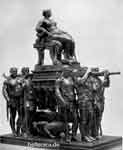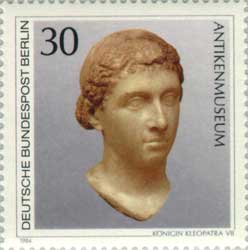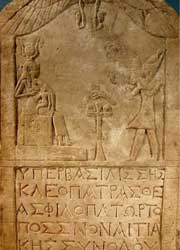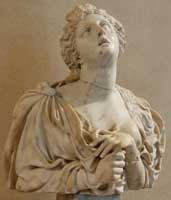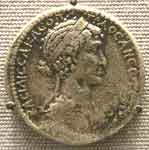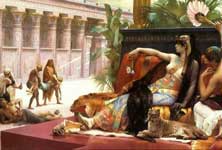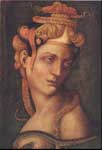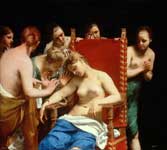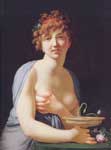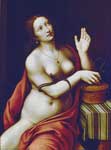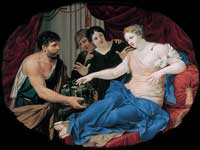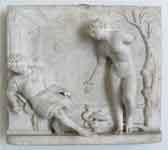.
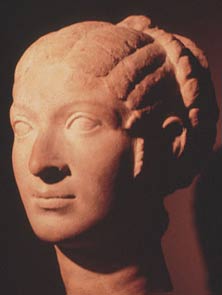
Last Ptolemaic Queen of Egypt with Ptolemy XII, Ptolemy XIII, Ptolemy XIV, and Ptolemy XV
Preceded by: Ptolemy XII
Cleopatra VII Philopator (Κλεοπάτρα Ζ', December, 70 BC or January, 69 BC–August 12?, 30 BC) was queen of ancient Egypt. She was the last member of the Macedonian Ptolemaic dynasty and hence the last Greek ruler of Egypt. Her father was Ptolemy XII Auletes, and her mother was probably Auletes's sister, Cleopatra V Tryphaena. The name Cleopatra is Greek for "father's glory".
Today she is probably the most famous of all of ancient Egypt's rulers, and is usually known as simply Cleopatra, all of her similarly-named predecessors having been largely forgotten. Cleopatra was never in fact the sole ruler of Egypt; she only co-ruled with her father, brother, brother-husband, and son. However, in all these cases, her co-rulers were king in title only, with her keeping the true authority.
Cleopatra is distinguishable as the last of three women ever to use the title Pharaoh. Her predecessors were Nitocris of the Sixth Dynasty and Hapshepsut of the Eighteenth Dynasty.
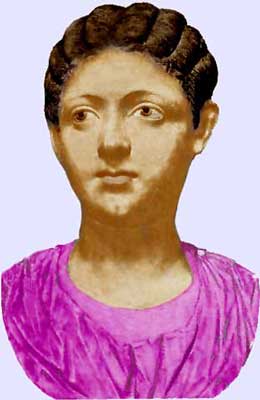
Cleopatra in Naples National Museum (did Caesar love this young girl ?)
History
Cleopatra VII was Greek and born in Egypt, took the throne alone at the death of her father Ptolemy XII in spring 51 BC. She was at the time the oldest child of Auletes, since two older sisters had died. She also had one younger sister whose name was Arsinoë. She was first briefly co-ruler with her father. She was subsequently co-ruler with two of her brothers, Ptolemy XIII, who opposed the Roman domination, and Ptolemy XIV. Since the Ptolomaic throne was transmited in matrilinear fashion, the Kings had to marry their sisters in order to be qualified to rule. Following the deaths of her brothers she named her eldest son co-ruler as Ptolemy XV Caesarion (44–-30 BC).
In 48 BC, the advisors of Ptolemy XIII, led by the eunuch Pothinus, removed Cleopatra's power and forced her to flee Egypt. Her sister Arsinoë accompanied her. Later that year, however, Ptolemy imperiled his own power by injudiciously meddling in the affairs of Rome. When Pompey, fleeing the victorious Julius Caesar, arrived in Alexandria seeking sanctuary, Ptolemy had him murdered in order to ingratiate himself with Caesar. Caesar was so repelled by this treachery that he seized the Egyptian capital and imposed himself as arbiter between the rival claims of Ptolemy and Cleopatra. (It should be noted that Pompey had been married to Caesar's daughter, who died giving birth to their son). After a short war, Ptolemy XIII was killed and Caesar restored Cleopatra to her throne, with Ptolemy XIV as new co-ruler.
Caesar wintered in Egypt in 48 BC–47 BC, and Cleopatra shored up her political advantage by becoming his lover. Egypt remained independent, but three Roman legions were left to protect it. Cleopatra's winter liaison with Caesar produced a son whom they named Ptolemy Caesar (nicknamed Caesarion, little Caesar). However, Caesar refused to make the boy his heir, naming his grand-nephew Octavian instead.
Cleopatra and Caesarion visited Rome between 46 BC and 44 BC and were present when Caesar was assassinated. Before or just after she returned to Egypt, Ptolemy XIV died mysteriously. Cleopatra then made Caesarion her co-regent. She may have poisoned her brother.
In 42 BC, Mark Antony, one of the triumvirs who ruled Rome in the power vacuum following Caesar's death, summoned Cleopatra to meet him in Tarsus to answer questions about her loyalty. Cleopatra arrived in great state, and so charmed Antony that he chose to spend the winter of 42 BC–41 BC with her in Alexandria. During the winter, she became pregnant with twins, who were named Cleopatra Selene and Alexander Helios.
Four years later, in 37 BC, Antony visited Alexandria again while en route to make war with the Parthians. He renewed his relationship with Cleopatra, and from this point on Alexandria would be his home. He may have married Cleopatra according to the Egyptian rite (a letter quoted in Suetonius suggests this), although he was at the time, married to Octavia, sister of his fellow triumvir Octavian. He and Cleopatra had another child, Ptolemy Philadelphus. At the Donations of Alexandria in late 34 BC, following Antony's conquest of Armenia, Cleopatra and Caesarion were crowned co-rulers of Egypt and Cyprus; Alexander Helios was crowned ruler of Armenia, Media, and Parthia; Cleopatra Selene was crowned ruler of Cyrenaica and Libya; and Ptolemy Philadelphus was crowned ruler of Phoenicia, Syria, and Cilicia. Cleopatra also took the title of Queen of Kings.
There are a number of unverifiable but famous stories about Cleopatra, of which one of the best known is that, at one of the lavish dinners she shared with Antony, she playfully bet him that she could spend ten million sesterces on a dinner. He accepted the bet. The next night, she had a conventional, unspectacular meal served; he was ridiculing this, when she ordered the second course — only a cup of strong vinegar. She then removed one of her priceless pearl earrings, dropped it into the vinegar, allowed it to dissolve, and drank the mixture.
Antony's behaviour was considered outrageous by the Romans, and Octavian convinced the senate to levy war against Egypt. In 31 BC Antony's forces faced the Romans in a naval action off the coast of Actium. Cleopatra was present with a fleet of her own, but when she saw that Antony's poorly equipped and manned ships were losing to the Romans' superior vessels, she took flight. Antony abandoned the battle to follow her.
Following the battle of Actium, Octavian invaded Egypt. As he approached Alexandria, Antony's armies deserted to Octavian. Cleopatra and Antony both committed suicide, Cleopatra by using a snake to poison herself on August 12, 30 BC. Cleopatra's son by Caesar, Caesarion was executed by Octavian. The three children of Cleopatra with Antony were spared and taken back to Rome where they were reared by Antony's wife, Octavia.
It is often said that Cleopatra used an asp to kill herself. "Asp" technically refers to a variety of venomous snakes, but here, it refers to the Egyptian cobra, which was sometimes used to execute criminals. There is also a story that Cleopatra asked several of her servants to test out various forms of suicide, before choosing the method which she believed to be most effective.
A Macedonian Greek by language and culture, Cleopatra is reputed to have been the first member of her family in their 300-year reign in Egypt to have learnt the Egyptian language.
Images
![]()
A famous question, dependence of history on the length of Cleopatra's nose.
Cleopatra in art, film, TV, and literature
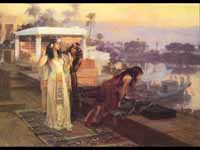

Cleopatra on the terraces of Philae, Cleopatra's Barge,
Cleopatra's story has fascinated scores of writers and artists through the centuries. No doubt, much of her appeal lay in her legend as a great seductress who was able to ally herself with two of the most powerful men (Caesar and Antony) of her time.
Among the more famous works on her:
Cléopâtre by Jules-Émile-Frédéric Massenet
Incipit Legenda Cleopatrie Martiris, Egipti Regine from Geoffrey Chaucer's The Legend of Good Women
Antony and Cleopatra by William Shakespeare
All for Love by John Dryden
Cléopatre by Victorien Sardou
Caesar and Cleopatra by George Bernard Shaw
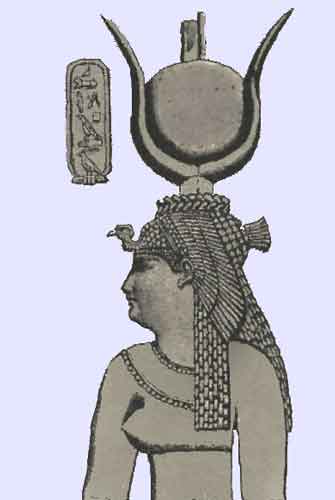
Egyptian image of Cleopatra VII
Films about Cleopatra
- The earliest Cleopatra-related motion picture was Antony and Cleopatra (1908) with Florence Lawrence as Cleopatra. The earliest film on Cleopatra as the main subject was Cleopatra, Queen of Egypt, starring Helen Gardner (1912).
- Among the film/TV works inspired by the Queen of the Nile:
- (1917): Cleopatra: Theda Bara (Cleopatra), Fritz Leiber (Caesar), Thurston Hall (Antony). Directed by J. Gordon Edwards. Based on Émile Moreau's play Cléopatre, Sardou's play Cléopatre, and Shakespeare's Antony and Cleopatra.
- (1934): Cleopatra: Claudette Colbert (Cleopatra), Warren William (Caesar), Henry Wilcoxon (Antony). Oscar-winning Cecil B. DeMille epic.
- (1946): Caesar and Cleopatra: Vivien Leigh (Cleopatra), Claude Rains (Caesar), Stewart Granger, Flora Robson — Oscar-nominated version of George Bernard Shaw's play. Leigh also played Cleopatra opposite then-husband's Laurence Olivier's Caesar in a later London stage version.
- (1963): Cleopatra: Elizabeth Taylor (Cleopatra), Rex Harrison (Caesar), Richard Burton (Antony). Oscar-winning block-buster most (in)famously remembered for the off-screen affair between Taylor and Burton. In 1964, Carry On Cleo spoofed this, with Amanda Barrie as Cleopatra, and Sid James as Mark Antony.
- (1974): Antony & Cleopatra: performed by London's Royal Shakespeare Company. Starred Janet Suzman (Cleopatra), Richard Johnson (Antony), and Patrick Stewart (Enobarbus).
- (1999): Cleopatra: Leonor Varela (Cleopatra), Timothy Dalton (Caesar), Billy Zane (Antony). Based on the book Memoirs of Cleopatra by Margaret George and closer to the facts than the others.
- Teresa Pavlinek portrayed Cleopatra in an episode of History Bites set during the Battle of Actium.
A longer discussion of Cleopatra films is at: Cleopatra (movie).
Cleopatra on TV
- All seven queens bearing the name Cleopatra were featured in the BBC mini-series The Cleopatras (1983)
A Large List of Cleopatra Movies from IMDB
Paintings of Cleopatra

The Banquet of Cleopatra, Giovanni Battista Tiepolo
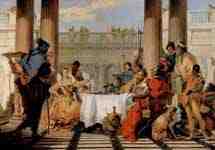
The Banquet of Cleopatra, Giovanni Battista Tiepolo
Cleopatra, Angelo Bronzino
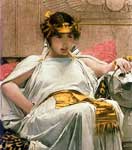
Cleopatra, John William Waterhouse
Cleopatra, Jost Amman
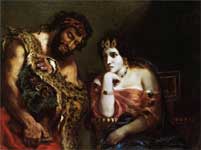
Cleopatra and the Peasant, Eugene Delacroix
Cleopatra testing poisons on condemned prisoners, Alexandre Cabanel
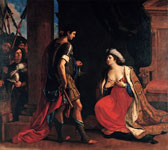
Cleopatra and Octavian, Guercino
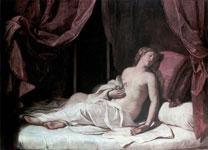
The Death of Cleopatra, Guercino
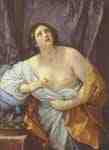
Cleopatra, Guido Reni
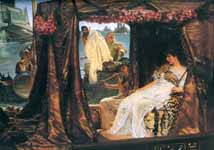
Antony and Cleopatra, Lawrence Alma-Tadema

The Banquet of Cleopatra, detail, Johann Georg Platzer
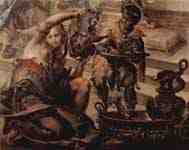
The Banquet of Cleopatra, detail, Johann Georg Platzer
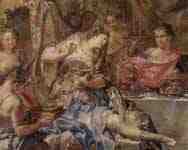
The Banquet of Cleopatra, detail, Johann Georg Platzer
Death of Cleopatra, Polychronis Lempesis
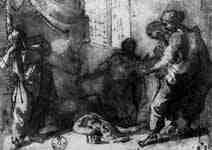
Death of Cleopatra, Giovanni da San Giovanni
- Head of Cleopatra (1533/34), Michelangelo
- Cleopatra , G. Francesco Guerrieri (1589 - 1657)
- The Death of Cleopatra, 1622-24, Johann Liss (c. 1595-1630) , Alte Pinakothek, Munich
- Suicide of Cleopatra. Oil on canvas. 46 x 36-3/4 in. (116.8 x 93.3 cm) painted by Giovanni Francesco Barbieri, also called Guercino. Painted in 1621 and which hangs in the collection in the Norton Simon Museum in Pasadena, California, USA. It shows Cleopatra and in her hand a snake that she prepares to use in her suicide.
- The Death of Cleopatra, 1660, Cagnacci, Guido (1601-1681), Art History Museum, Vienna
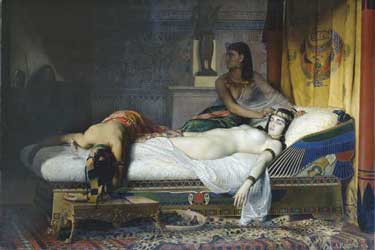
- The Death of Cleopatra, painted 1874 by Jean André Rixens and which hangs in the Musee des Augustins in Toulouse, France.
- The Banquet of Cleopatra (1743–/5). Oil on Canvas, 248.2 x 357.8cm. Painted by Giambattista Tiepolo (1696–-1770), which hangs in the National Gallery of Victoria, Australia, depicting the banquet in which Cleopatra disolves her pearl earring in a glass of vinegar.
- Cleopatra and Caesar (Cléopâtre et César) (1866). Oil on Canvas. Painted by Jean-Léon Gérôme (1824–-1904). The original painting has been lost, and only copies remain. The work depicts Cleopatra standing before a seated Caesar, painted in the Orientalist style.
- Cleopatra and the Peasant (1838). Oil on canvas. Painted by Eugène Delacroix. Hanging in the Ackland Art Museum, University of North Carolina, USA. The work shows a man providing Cleopatra with the snake she uses to kill herself with.
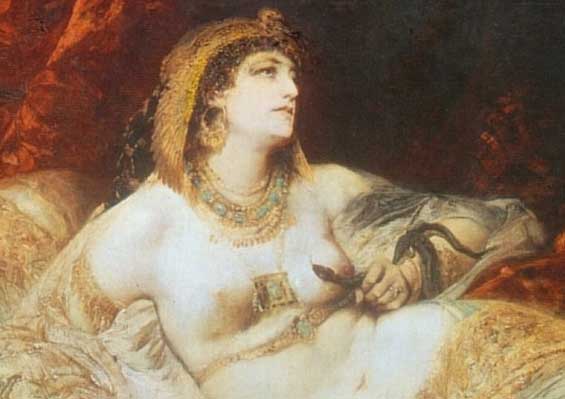
- Part of "Der Tod der Kleopatra" (The death of Cleopatra) , Painted by Hans Makart , 1875, Germany.
- The Meeting of Antony and Cleopatra, 41 BC (1883), Lawrence Alma-Tadema
- Cleopatra, 1911 , Gyula Benczúr (1844–1920) , Déri Múzeum, Debrecen
Music
Handel’s opera Giulio Cesare, the Canadian-Armenian soprano Isabel Bayrakdarian as Cleopatra
Fun
- Asterix and Cleopatra
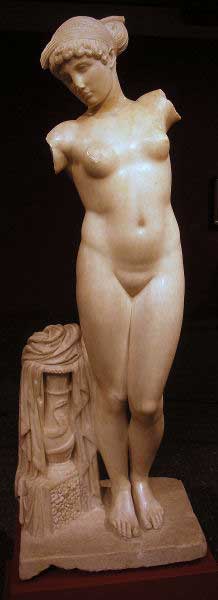
Venus of Esquilin (Source), some experts believe that it represents actually Cleopatra VII
|
The Death Of Cleopatra, after 1659, Guido Cagnacci |
||
|
Antony and Cleopatra, Lawrence Alma-Tadema |
Cleopatra, Angelo Bronzino |
|

Cleopatra Leonhard Kern |
| Ancient Greece
Science, Technology , Medicine , Warfare, , Biographies , Life , Cities/Places/Maps , Arts , Literature , Philosophy ,Olympics, Mythology , History , Images Medieval Greece / Byzantine Empire Science, Technology, Arts, , Warfare , Literature, Biographies, Icons, History Modern Greece Cities, Islands, Regions, Fauna/Flora ,Biographies , History , Warfare, Science/Technology, Literature, Music , Arts , Film/Actors , Sport , Fashion --- |
Retrieved from "http://en.wikipedia.org"
All text is available under the terms of the GNU Free Documentation License

